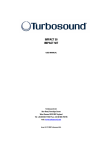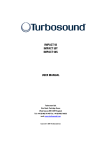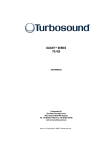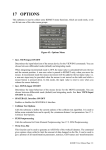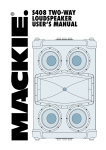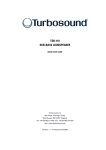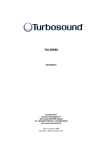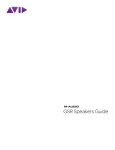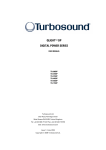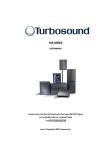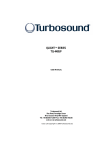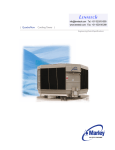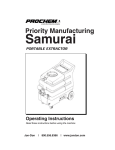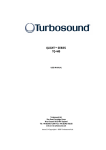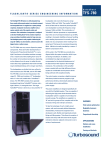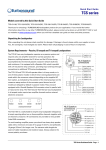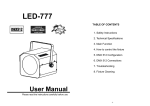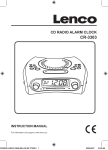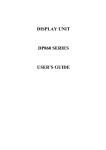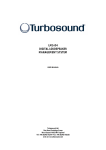Download QLIGHT TQ-300 SERIES
Transcript
QLIGHT TQ-300 SERIES USER MANUAL TQ-310 TQ-315 Turbosound Ltd. Star Road, Partridge Green West Sussex RH13 8RY England Tel: +44 (0)1403 711447 Fax: +44 (0)1403 710155 web: www.turbosound.com Issue 1.0 Copyright 2001 Turbosound Ltd. user manual QLight series CONTENTS Introduction ................................................................................................................................................. 3 Thanks................................................................................................................................................... 3 Unpacking the TQ series loudspeaker ............................................................................................... 3 Features ....................................................................................................................................................... 4 Product Range Summary........................................................................................................................... 5 TQ-310 passive two way loudspeaker ............................................................................................... 5 TQ-315 bi-amped two-way loudspeaker............................................................................................ 6 Amplifier Considerations .................................................................................................................... 7 Equalisation .......................................................................................................................................... 9 Converging Elliptical Waveguide .................................................................................................... 9 Mounting and Fixing ................................................................................................................................ 10 Rigging Hardware .............................................................................................................................. 10 Permanent Installations..................................................................................................................... 11 Choosing the best location ............................................................................................................... 12 Maintenance – TQ-310.............................................................................................................................. 13 Removal of the Low Frequency Driver ............................................................................................ 13 Removal of the HF unit...................................................................................................................... 13 Maintenance – TQ-315.............................................................................................................................. 14 Removal of the Low Frequency Driver ............................................................................................ 14 Removal of the HF unit...................................................................................................................... 14 Appendix A................................................................................................................................................ 15 Spares and accessories ..................................................................................................................... 15 Appendix B ................................................................................................................................................ 16 Appendix B ................................................................................................................................................ 16 Technical Specifications.................................................................................................................... 16 Appendix C: Warranty .............................................................................................................................. 17 TQ-300 series manual page 2 user manual QLight series INTRODUCTION Thanks Thank you for choosing a QLight 300 series loudspeaker product for your application. Please spare a little time to read the contents of this manual, so that you can obtain the best possible performance from this unit. All TURBOSOUND products are carefully engineered for world-class performance and reliability. If you would like further information about this or any other TURBOSOUND product, please contact us. Detailed product information is available on our web site at www.turbosound.com We look forward to helping you in the near future. Congratulations, you have just purchased a professional loudspeaker system from the renowned Turbosound range, designed to give you the best in audio quality and many years of reliable, trouble free operation. It offers superior audio quality, unsurpassed vocal projection, full technical documentation including EASE data, and comprehensive rigging and flying hardware options. Please read through this manual carefully before you attempt to operate the loudspeaker system. It contains valuable information enabling you to quickly and easily set up and connect the loudspeakers, important system and set-up checks together with positioning and mounting instructions. Unpacking the TQ series loudspeaker After unpacking the unit please check carefully for damage. If damage is found, please notify the carrier concerned at once. You, the consignee, must instigate any claim. Please retain all packaging in case of future re-shipment. TQ-300 series manual page 3 user manual QLight series FEATURES • Superb audio quality: carefully designed and matched loudspeaker drive units are used to give you exceptional performance and many years of reliable, trouble free operation. • Converging Elliptical Waveguide: eliminates reflections in the horn throat and gives excellent pattern control. • Rotatable HF waveguides: high frequency waveguides are designed to accommodate 90° rotation within the enclosure for horizontal or vertical orientation. • Ease of use: QLight 300 series products are exceptionally easy to set up and use with the minimum of technical knowledge required. • Multiple applications: the non-symmetrical enclosure shape of the TQ-310 and TQ-315 allow them to be used both in front of house loudspeaker systems as well as for floor monitor applications. • Wide dynamic range: all drive units are capable of handling large amounts of amplifier power in order to achieve high SPL without losing headroom. • Wide dispersion: QLight 300 series enclosures exhibit wide dispersion patterns which maximise the sound coverage directed at audience areas. • Aligned components: low and high frequency components are physically aligned in the enclosure to ensure perfect time arrival at the listener’s ear. • Solid construction: all QLight 300 series cabinets are built from high-grade birch plywood, rebated, screwed and glued together for maximum rigidity and durability. • Integral rigging points: fitted as standard, enabling use with optional Turbosound flying hardware, as well as OmniMount and Powerdrive brackets, for all types of fixed installations and mobile sound reinforcement applications. • Compact enclosures: the overall dimensions of all QLight 300 series enclosures have been kept as small as possible to enable portable use as well as fitting easily into permanent installations. TQ-300 series manual page 4 user manual QLight series PRODUCT RANGE SUMMARY TQ-310 passive two way loudspeaker The TQ-310 is a trapezoidal passive full range two-way loudspeaker enclosure designed for use in mobile speech and music sound reinforcement applications, including use as a floor monitor, as well as in a wide range of fixed installations. The loudspeaker complement consists of a front loaded 10” low frequency driver and a 1” high frequency compression driver on a 100°H x 60°V HF waveguide, matched with an internal passive crossover network. The TQ-310 features Turbosound’s Converging Elliptical Waveguide™ (CEW™) technology. The comparatively short flare allows physical alignment of the HF and LF devices, and ensures that the wavefront is shaped smoothly, eliminating reflections in the throat area while giving excellent pattern control. Additionally this design does not suffer from the distortion typical of horns employing diffraction edges. The waveguide can be rotated within the enclosure, making it possible to swap the horizontal and vertical coverage patterns, for example when installing the TQ-310 horizontally. The quasi-trapezoidal enclosure has been designed with a 15° side angle on one side, and with a 15° and 45° angle on the other. This shape allows the loudspeaker to be used for ether front of house or as a floor monitor. The TQ-310 includes the provision for fitting optional RT-767 ring-type fittings, two on the top and one on the rear, enabling it to be suspended and angled in permanent installations as well as in mobile applications. A pole mount socket is fitted for use with 35mm poles and speaker stands. M10 rigging points are provided on the sides for horizontal orientation. It is also compatible with optional Turbosound hardware, as well as Omnimount and Powerdrive brackets. The cabinet is constructed from 12mm (1/2”) birch plywood, screwed and glued together for maximum strength and rigidity, and includes a reticulated foam and steel mesh grille. It is finished in durable semi-matt black textured paint; TurboBlue textured paint is optionally available. A rear panel connector plate carries two Neutrik Speakon NL4MP connectors for loop in and loop out connections to additional enclosures. The TQ-310 is intended for use with professional quality digital controllers providing at least five parametric EQ points per output, and output limiting functions. The TQ-310 is a full range loudspeaker, and used by itself will provide high quality audio for all speech and many music reproduction applications. In order to extend the effective bass frequency range of the loudspeaker by a further octave the use of the complementary TQ-115 or TQ-425 subwoofer is recommended. TQ-300 series manual page 5 user manual QLight series TQ-315 bi-amped two-way loudspeaker The TQ-315 is a trapezoidal, switchable bi-amped/passive two-way loudspeaker enclosure, designed for use in mobile speech and music sound reinforcement applications as well as in a wide range of fixed installations. The loudspeaker complement consists of a front loaded 15” low frequency driver and a 3” diaphragm high frequency compression driver on a 80°H x 50°V HF waveguide. The TQ-315 may be used either in bi-amped mode, or in fully passive mode by means of a rear panel switch. The TQ-315 features Turbosound’s Converging Elliptical Waveguide (CEW). The comparatively short flare allows physical alignment of the HF and LF devices, and ensures that the wavefront is shaped smoothly, eliminating reflections in the throat area. Additionally this design does not suffer from the distortion typical of horns employing diffraction edges. The waveguide can be rotated within the enclosure, making it possible to swap the horizontal and vertical coverage patterns, for example when installing the TQ-315 horizontally. The quasi-trapezoidal enclosure has been designed with a 15° side angle on one side, and with a 15° and 45° angle on the other. This shape allows the loudspeaker to be used for either front of house applications or as a floor monitor. The TQ-315 includes the provision for fitting optional RT-767 ring-type fittings, on the top, bottom and rear, enabling it to be rigged in permanent installations as well as in mobile applications. A pole mount socket is fitted for use with 35mm poles and speaker stands. It is also compatible with Omnimount 300 series and Powerdrive 120 series wall and ceiling brackets. M10 rigging points are provided on the sides for installing in a horizontal orientation. The cabinet is constructed from 15mm (5/8”) birch plywood, screwed and glued together for maximum strength and rigidity, and it is finished as standard in durable semi-matt black textured paint. TurboBlue textured paint is optionally available. An acoustically transparent, reticulated foam and perforated steel mesh grille protects the drive units. A rear panel connector plate carries two Neutrik Speakon NL4MP connectors for loop in and loop out connections to additional enclosures, and a recessed toggle switch for bi-amped/passive mode selection. The TQ-315 is intended for use with professional quality digital controllers providing two inputs and four outputs, with at least five parametric EQ points per output, and output limiting functions. TQ-300 series manual page 6 user manual QLight series System requirements for QLight 300 series products The TQ-310 is a passive loudspeaker enclosure, meaning that it requires only one amplifier channel for correct operation, the frequency splitting between the low frequency driver and the high frequency driver being accomplished by the internal passive crossover network built into each enclosure. If subwoofer enclosures are used as part of a bi-amplified system in conjunction with QLight 300 series 2-way enclosures to extend low frequency response, additional amplifier channels and external electronic crossovers will be required. The Turbosound LMS-D6 digital loudspeaker management system is recommended for this purpose, as well as other professional quality digital controllers. The TQ-315 is a bi-amplified loudspeaker, meaning that each frequency band requires the use of one amplifier channel for correct operation. Frequency splitting between the low frequency driver and the high frequency driver is accomplished by an external electronic crossover. The Turbosound LMS-D6 digital loudspeaker management system is recommended for this purpose, as well as other professional quality digital controllers. If subwoofer enclosures are used as part of a bi-amplified system in conjunction with the TQ-310 or TQ-315 to extend low frequency response, additional amplifier channels and external electronic crossovers will be required. Amplifier Considerations Turbosound speaker enclosures should be driven by high quality power amplifiers designed for true professional use. Such amplifiers will have balanced inputs, DC and RF fault protection, and well designed cooling systems for reliability. Turbosound power amplifiers such as the TMC-1250, TMC-750 and TMC-T1000 are recommended for this purpose. The program power listed in the loudspeaker’s technical specification is the best guide to the size of amplifier required for general purpose applications. The amplifier should therefore be capable of delivering long term broadband power equal to the loudspeaker’s program power rating at the loudspeaker’s stated nominal impedance. This approach allows sufficient headroom to generate good dynamic range. RECOMMENDED AMPLIFIER POWER RATINGS: The amplifier's rated r.m.s. continuous power output (20Hz – 20kHz, per channel) should be equal to the program power handling of the loudspeaker at its nominal impedance. TQ-300 series manual page 7 user manual QLight series In general, the more powerful the amplifier, the better it will sound, provided that it is not driven into sustained clipping. It should be understood that overdriving an insufficiently powered amplifier is more likely to cause loudspeaker damage – the total energy in a heavily clipped signal is far higher than in an unclipped signal – than operating a more powerful amplifier within its ratings. One loudspeaker management system can be used to feed several amplifiers as long as all the amplifiers are the same (or have the same gain ratings). More than one loudspeaker management system may be required if the amplifiers are of different gain or type. Please contact your dealer if you require help in this area. TQ-300 series manual page 8 user manual QLight series Equalisation QLight 300 series enclosures are designed to provide smooth and even frequency response. They do not need excessive amounts of external equalisation to overcome the sonic deficiencies often found in many lesser designs. Should an extended frequency response be required at more than moderate sound pressure levels, the use of complementary TQ-115 or TQ-425 subwoofer enclosures is strongly recommended. In order to compensate for the room acoustics, QLight 300 series enclosures require only minimal equalisation. As in any system, over-equalisation introduces phase shifts, distortion and a reduction in headroom, usually causing more problems than it cures. Under most circumstances a 1/3 or 1/2 octave graphic equaliser will generally be adequate, with the fader settings applied smoothly and as little as possible for the required room compensation. Most rooms will have resonances that will be excited at particular frequencies needing some cut to help tame the sound. These problems are most pronounced at the lower frequencies where loudspeakers generally exhibit very little directional control. If you find that the system needs a lot of boost at lower frequencies you may need additional sub-bass units. It is good practice to use as little equalisation as possible, aiming to cut frequencies rather than adding large amounts of boost. Converging Elliptical Waveguide A design feature of the TQ-310 and TQ-315 is the Converging Elliptical Waveguide (CEW), available in two directivity patterns: 100° x 60° for the TQ-310 and 80° x 50° for the TQ-315. This gives many user advantages. The comparatively short flare length allows the HF and LF components to be physically aligned in the cabinet, so ensuring coherent arrival at the listener’s ear irrespective of distance from the loudspeaker. The elliptical format shapes the wavefront smoothly, and eliminates reflections in the throat area. Additionally this design does not suffer from the distortion typical of horns employing diffraction edges. The waveguides can be removed and rotated through 90º in the cabinet, which allows the products to be installed in either vertical or horizontal formats while retaining the required coverage. TQ-300 series manual page 9 user manual QLight series MOUNTING AND FIXING Rigging Hardware A versatile range of mounting hardware is available that allows enclosures to be used in a variety of ways, in either mobile applications or permanent installations. A top hat stand type fitting is mounted in the base of both cabinets for use with 35mm diameter loudspeaker stands with a load rating of at least 37kgs (82lbs). An optional 35mm diameter straight pole used between these enclosures enables a minimum footprint and ensures the correct vertical distance between cabinets. RT-767 ring type flying points. Rigging points are provided on the top and rear of the TQ-310 for use with optional RT-767 rings, enabling it to be rigged in permanent installations and for mobile applications. Downward inclination of the enclosure can be adjusted using the RT-767 rigging point on the rear of the cabinet. The TQ-310 can also be installed with M10 shoulder eyebolts in a horizontal orientation using the M10 internal rigging points on the side of the cabinet. In this case use the rear RT-767 flypoint on the rear as a pull-back. The SB-310 swivel bracket provides a means of wall mounting the TQ-310 in either a horizontal or vertical orientation. The swivel bracket is attached to the box using the integral pole mount fitting at the bottom and the M8 internal rigging point on the top of the cabinet. TQ-300 series manual page 10 user manual QLight series For applications requiring the TQ-310 to be installed rapidly in a horizontal format, an additional scaffold clamp assembly attaches to the SB-310 swivel bracket. This method allows a virtually unlimited range of placement angles. The TQ-315 is fitted with rigging points on the top, bottom and rear for use with optional RT-767 ring-type flying points. The rear RT-767 rigging point provides a means of adjusting the downward angle of the cabinet. M10 rigging points are provided on each side to allow the enclosure to be flown horizontally using the rear RT-767 point as a pull-back. M8 rigging points are provided on the rear of the cabinet for use with OmniMount 300 series and Powerdrive 120 series wall and ceiling brackets. Permanent Installations Any installation, whether temporary or permanent, must be securely attached to the structure of the building using chain, steel wires or web straps which are certified and load rated for the purpose. The combined weight of the sound system, its cables and the rigging system must be safely carried by the points at which attachment is made to the building or structure. Great care must be taken in selecting the attachment points and methods, being absolutely sure of the load carrying capacity of points chosen. TQ-300 series manual page 11 user manual QLight series NOTE: The rigging of loudspeaker systems is an extremely serious matter with potentially lethal consequences should anything go wrong. It is of vital importance that you, or other people rigging the system, are suitably qualified to do so and have a full understanding of all the factors involved with safety as a number one priority. Turbosound accepts no responsibility for any accident, damage or failure of any rigged system. This rigging information is specifically related to the requirements of the TQ-310 and TQ-315 only. For more detailed information on the whole topic of rigging various handbooks are available. If you are in any doubt contact your Turbosound dealer who will be able to refer you to an experienced rigging company. Choosing the best location When using any QLight system, certain room parameters will affect the resultant sound quality and coverage. For example, any boundary like a wall or floor will lift certain frequencies. If you are placing the unit in a corner then a lift at the bass end is to be expected and it may sound rather boomy. This can be compensated for moving the speaker or cutting low frequencies with a graphic equaliser. When speakers are flown in free space then boundary effects are minimised. The result is a smooth frequency response without any boost at odd frequencies, but the bass end may appear subjectively light. In this case increase the sub-bass level to bring the low end up. The relationship between sound pressure level and distance is an “inverse square law” so remember that every time the distance from the sound source is doubled the sound level decreases by 6dB. For every 3dB increase of speaker output you need a doubling of input power and you can work out the wattage input needed to give the required SPL levels at various distances from the loudspeaker(s). TQ-300 series manual page 12 user manual QLight series MAINTENANCE – TQ-310 If any of the drive units should cease functioning and needs a replacement recone you are advised to remove the faulty unit from the cabinet and send it to a professional recone service authorised to recone Turbosound loudspeakers. This will ensure the continued high performance of your QLight series product. Removal of the Low Frequency Driver 1. Unscrew the six countersunk socket head screws at the side of the cabinet that hold the protective grille in place. Be careful when removing the grille as it is under tension and may spring outwards when released. Set the grille and fixing screws aside for later re-assembly. 2. Undo the four Allen head bolts holding the driver in place, and carefully pull it out and away from the cabinet. WARNING - this unit is heavy! Disconnect the cables from the loudspeaker terminals and completely remove the driver from the cabinet. Make a note of the driver polarity for later reconnection. 3. To reinstate the driver, simply reverse the procedure making sure you observe the correct polarity when reconnecting the cables back into the terminals of the drive units. Removal of the HF unit 1. Unscrew the six countersunk socket head screws at the side of the cabinet that hold the protective grille in place. Be careful when removing the grille as it is under tension and may spring outwards when released. Set the grille and fixing screws aside for later re-assembly. 2. Unscrew the four Allen head bolts holding the high frequency range horn in place and carefully pull it out and away from the cabinet. WARNING - this unit is heavy! Disconnect the cables from the loudspeaker terminals and completely remove the driver from the cabinet. Make a note of the driver polarity for later reconnection. 3. To reinstate the driver, simply reverse the procedure making sure you observe the correct polarity when reconnecting the cables back into the terminals of the drive units. TQ-300 series manual page 13 user manual QLight series MAINTENANCE – TQ-315 Removal of the Low Frequency Driver 1. Unscrew the six countersunk socket head screws at the side of the cabinet that hold the protective grille in place. Be careful when removing the grille as it is under tension and may spring outwards when released. Set the grille and fixing screws aside for later re-assembly. 2. Undo the four Allen head bolts holding the driver in place, and carefully pull it out and away from the cabinet. WARNING - this unit is heavy! Disconnect the cables from the loudspeaker terminals and completely remove the driver from the cabinet. Make a note of the driver polarity for later reconnection. 3. To reinstate the driver, simply reverse the procedure making sure you observe the correct polarity when reconnecting the cables back into the terminals of the drive units. Removal of the HF unit 1. Unscrew the six countersunk socket head screws at the side of the cabinet that hold the protective grille in place. Be careful when removing the grille as it is under tension and may spring outwards when released. Set the grille and fixing screws aside for later re-assembly. 2. Remove the centre portion of the top grille support bracket, which will allow the horn and driver to come out easily. Unscrew the four Allen head bolts holding the high frequency range horn in place and carefully pull it out and away from the cabinet. WARNING - this unit is heavy! Disconnect the cables from the loudspeaker terminals and completely remove the driver from the cabinet. Make a note of the driver polarity for later reconnection. 3. To reinstate the driver, simply reverse the procedure making sure you observe the correct polarity when reconnecting the cables back into the terminals of the drive units. Replace the top grille support bracket before re-fitting the grille. TQ-300 series manual page 14 user manual QLight series APPENDIX A Spares and accessories CD-110 1” (25mm) HF compression driver for TQ-310 RD-110 Replacement diaphragm for CD-110 CD-208 3” diaphragm (76mm) HF compression driver for TQ-315 RD-208 Replacement diaphragm for CD-208 LS-1018 10” (254mm) LF loudspeaker for TQ-310 RC-1018 Recone kit for LS-1018 LS-1520 15” (381mm) LF loudspeaker for TQ-315 RC-1520 Recone kit for LS-1520 PX-310 Passive crossover network for TQ-310 PX-315 Passive crossover network for TQ-315 MG-310 Replacement foam / metal grille for TQ-310 MG-315 Replacement foam / metal grille for TQ-315 Flying accessories RT-767 Ring-type flying points (set of three) CB-100 Ceiling bracket WB-100 Wall bracket SB-310 Swivel bracket SC-440 Scaffold clamp TQ-300 series manual page 15 user manual QLight series APPENDIX B Technical Specifications TQ-310 TQ-315 525mm x 319mm x 277mm 691mm x 443mm x 381mm (20.7” x 12.5” x 10.9”) (27.2” x 17.4” x 15”) Net weight 21kgs (46.2lbs) 35.5kgs (78.1lbs) Components 1 x 10” (254mm) LF driver 1 x 15” (381mm) LF driver 1 x 1” (25mm) HF compression 1 x 3” diaphragm (35mm) HF driver compression driver Frequency 65Hz – 20kHz ±4dB (with digital 55Hz – 20kHz ±4dB (with digital response controller) controller) Nominal 100°H x 60°V @-6dB points 80°H x 50°V @-6dB points Sensitivity 96dB, 1 watt @ 1 metre 99dB, 1 watt @ 1 metre Power handling 350 watts r.m.s., 700 watts LF: 600 watts r.m.s., 1200 watts program, 875 watts peak program, 1500 watts peak Dimensions dispersion HF: 80 watts r.m.s., 160 watts program, 200 watts peak Maximum SPL 124dB continuous, 130dB peak 130dB continuous, 136dB peak Construction 12mm (1/2”) birch plywood 15mm (5/8”) birch plywood throughout; rebated, screwed and throughout; rebated, screwed and glued. Finished in black semi-matt glued. Finished in black semi-matt textured paint. textured paint. Grille Connectors Reticulated foam on expanded steel Reticulated foam on expanded steel mesh mesh (2) Neutrik Speakon NL4MP (2) x Neutrik Speakon NL4MP, wired wired pin 1+: +ve, pin 1-: –ve pin1+:+ve, pin 1-: -ve. Active: pin1+: LF+; pin 1-: LF-; pin2+: HF+, pin2-: HF- Options TurboBlue semi-matt textured TurboBlue semi-matt textured paint paint Due to continuing product improvement the above specifications are subject to change. TQ-300 series manual page 16 user manual QLight series APPENDIX C: WARRANTY Limited Warranty This Turbosound loudspeaker product is warranted to the original end-user purchaser and all subsequent owners for a period of one (1) year for electronics assemblies and two (2) years for loudspeakers from the original date of purchase. Warranty Coverage Warranty coverage includes defects in materials and workmanship. It does not include: • damage caused by accident, misuse, abuse, neglect or modification by any person other than an authorised Turbosound representative, • damage caused by failure to operate the product in accordance with the instructions contained in the user manual, • damage occurring during shipment in transit, • claims based on any misrepresentation by the seller, • products which do not have the original components as specified in the product engineering information, • products on which the serial number has been removed or defaced. Shipping Should any fault develop with a component of your Turbosound system, please return the product, freight pre-paid, in its original packing carton, along with proof of purchase such as the original bill of sale or receipted invoice, and a description of the suspected fault to Turbosound Ltd. (Att: Customer Service), Star Road, Partridge Green, West Sussex RH13 8RY, England, or your local authorised Turbosound representative. The product serial number must be quoted in all correspondence relating to the claim. Insurance is recommended, as Turbosound or its representatives are not liable for loss or damage in transit. Turbosound will pay for return freight costs should repairs be covered under warranty. TQ-300 series manual page 17 user manual QLight series Incidental and consequential damages Turbosound's liability is limited to the repair or replacement, at our option, of any defective product, and shall not be liable for any incidental and consequential damages including, without limitation, injury to persons or property or loss of use. Limitation of implied warranties All implied warranties, including warranties of merchantability and fitness for a particular purpose, are limited in duration to the length of this warranty. This warranty is in addition to, and in no way detracts from, your statutory rights as a consumer. No other warranty is expressed or implied. Please record your purchase information below for future reference: Dealer Name ________________________________________________________________ Dealer Address ________________________________________________________________ ________________________________________________________________ ________________________________________________________________ TQ-300 series manual page 18 Post / Zip Code ________________________________________________________________ Dealer telephone / fax ________________________________________________________________ Invoice number ________________________________________________________________ Date of purchase ________________________________________________________________ Unit serial number ________________________________________________________________ Turbosound Ltd. Star Road, Partridge Green West Sussex RH13 8RY England Tel: +44 (0)1403 711447 Fax: +44 (0)1403 710155 web: www.turbosound.com



















